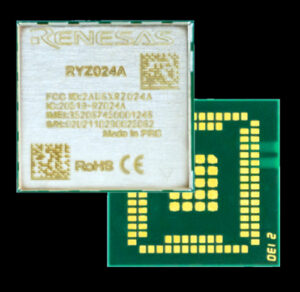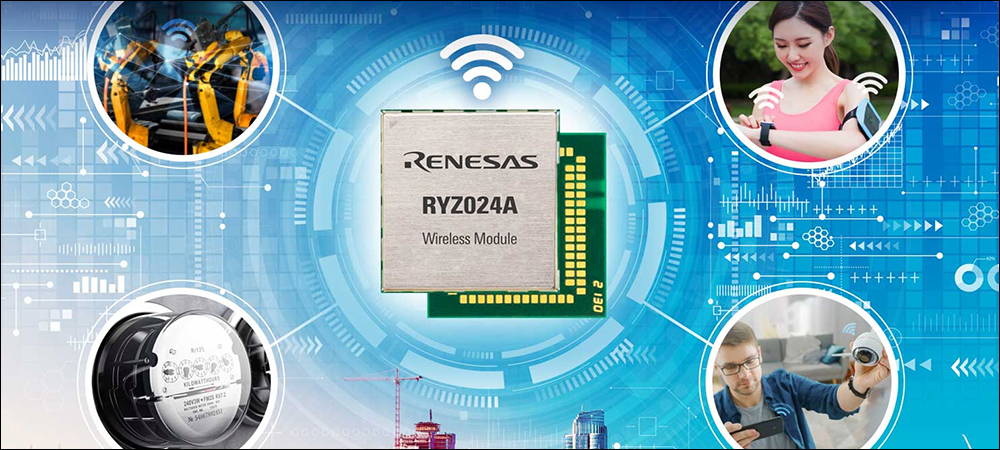- Internet of Things Use Becomes Global
- How the New Module Could Be Used
- High Data Rate and Power Alternative to LoRaWAN
Internet of Things (IoT) solutions that require low-power wide-area network (LPWAN) technologies employ one of several distinct communication standards, depending on the geographic area. For IoT solution providers, that means a device designed for use in one region or on one continent will not necessarily operate elsewhere. To address this issue, semiconductor solutions company Renesas Electronics has released its latest product, the RYZ024A module, which offers two standards: NB-IoT (narrowband IoT) Internet connectivity, as well as LTE Cat-M1. The new module was created in partnership with cellular IoT chip company Sequans Communications.

The RYZ024A module
Both types of cellular-based systems offer long-range transmission of large amounts of data, directly through local cellular networks. That offers an alternative to LoRaWAN, which is a global, open-standard network for sending small packets of data to a gateway. Renesas’s latest product expands its LPWAN product line, with the goal of delivering IoT options for smart cities, smart homes, medical devices and industrial applications. In addition to dual-mode connectivity, the RYZ024A module is available in a smaller size than its predecessors and consumes less power, according to Awanish Mishra, Renesas Electronics’ marketing head for IoT and connectivity.
The predecessor RYZ014A module offered Cat-M1 wireless connection capability only, the company explains, while the inclusion of NB-IoT offers several benefits. In scenarios for which both CAT-M1 and NB-IoT networking are available, NB-IoT is sometimes the best alternative for IoT applications. Because it uses only a portion of the available spectrum, devices can be more power-efficient and extend the operational life of battery-powered systems. Additionally, NB-IoT offers high coverage even in areas in which devices may be underground in enclosed spaces.
Internet of Things Use Becomes Global
One challenge the new module is intended to resolve is how to provide the connectivity required for specific geographic areas. The global rollout of cellular-based IoT networks has varied according to specific countries and their corresponding standards. The United States, Canada, Western Europe and Australia mostly use both LTE Cat-M and NB-IoT transmissions, meaning devices transmitting at either frequency can be supported by cellular networks. Mexico utilizes LTE Cat-M only, while the majority of Eastern Europe, Asia and the Middle East use NB-IoT only. NB-IoT is accepted in regions representing more than half of the total human population.
As a result, Mishra says, companies deploying IoT solutions either need separate sensors if their products are being used in different geographies, or they must isolate connectivity to the region in which their solutions are deployed. Renesas’ IoT technology is already in use for multiple applications, including asset tracking, smart homes, smart agriculture, utility management and EV charging stations. In many cases, the company’s customers provide technology for very large coverage areas.
Recently, Mishra says, “We have several customers we heard from that were using IoT for asset tracking, while others had metering systems, and in both cases, they wanted a device that could operate in any part of the world.” These customers, he explains, wanted to offer products capable of supporting all regional IoT combinations. “They needed to have something where they can use the best network that’s available.”
How the New Module Could Be Used

Awanish Mishra
Asset tracking is among the early adoption cases, in which a tagged item is tracked as it moves around the world. Companies using the new module are typically device manufacturers that build IoT connectivity into sensors and asset trackers, among other technologies. If a product used the new module for asset tracking, the device could receive signals from both Cat-M and NB-IoT transmissions, then automatically respond at the same frequency.
In that way, a tracker in a supply chain—measuring the temperatures of goods traveling from one continent to another, for example—could send relevant data as it moves from Malaysia to the Middle East, Europe or the United States. An agricultural solution provider similarly could develop sensors to monitor conditions in fields, such as measuring the humidity and temperature around crops, then forward the collected data to a global cloud-based server from any location.
The data rate at which an IoT system transmits is directly proportional to the system’s bandwidth, Mishra says. The higher the bandwidth, the higher the data rate. Unlicensed technologies such as LoRaWAN offer universal coverage if a gateway is deployed, but they use very low power and very small packets of data. If, however, users want to track conditions or an object’s location over geographical areas, and if they are transmitting a large amount of data to the cloud, they would typically select Cat-M or NB-IoT.
High Data Rate and Power Alternative to LoRaWAN
The RYZ024A supports extended discontinuous reception (eDRX), a function by which the module remains dormant for extended periods of times to reduce battery consumption. The module uses 1 microamp of current when in power-saving mode, which Mishra says is less than with competing products. With this functionality and a new chipset, the module uses 60 percent less power than the RYZ014A, the company reports.
One key performance indicator for these IoT modules is their ability to operate on a single battery for 10 years, Mishra says. The smaller module size offers another advantage for those building wireless devices, according to Renesas. This module measures 16.3 millimeters by 17 millimeters (0.6 inch by 0.7 inch), which is almost 50 percent smaller than the predecessor device.
According to Mishra, the module provides benefits for a variety of applications, including utility meter data collection, wireless industrial sensors, smart-home devices, health and fitness wearables, and pet trackers. Developers can leverage a connectivity kit with a quick-start guide explaining a step-by-step process by which to build the module into a product and enable the necessary SIM card. On Renesas’s website, users can download sample programs enabling them to connect and control the modules and create their own application projects.
At present, several alpha customers are actively designing with the developer kits, and the company expects new products will be released by next summer. In the meantime, Mishra says, “The need for data is growing day by day,” which is driving IoT deployments. “Everybody wants to consume more data. Everybody wants to send more and more data.” With this in mind, he says, “There are additional technologies on our roadmap which we will be launching in the coming quarters.”
Key Takeaways:
- Renesas’s new dual-frequency IoT module and software developer kits are intended to expand IoT deployments across geographies.
- Companies are already developing solutions and products that will leverage NB-IoT and Cat-M frequencies so that devices can seamlessly connect to a network in most parts of the world.


